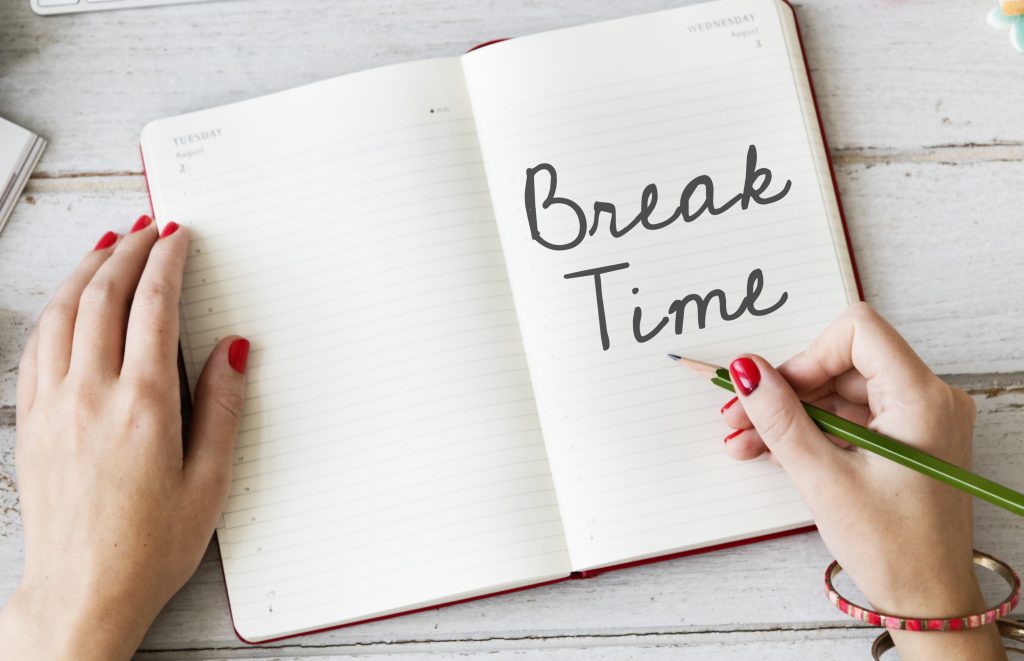In our fast-paced, always-on world, the idea of taking breaks can seem counterintuitive. For many people, taking a break feels like a disruption, a pause that will throw them off course and break their flow. Whether you’re working on a creative project, tackling a tough problem, or pushing through a long workday, the fear of losing your rhythm can make it tempting to power through without stopping.
But here’s the reality: breaks are essential. Not only do they prevent burnout and reduce stress, but they also help recharge your focus, creativity, and productivity. The trick lies in knowing how to take breaks without losing flow. In this article, we’ll explore how to balance work and rest, and provide strategies for taking breaks that will actually enhance your productivity and help you maintain momentum throughout the day.

The Importance of Breaks: Why You Need Them
Before we dive into how to take breaks without losing flow, it’s essential to understand why breaks are necessary. Research shows that taking regular breaks can have significant benefits for both mental and physical health.
-
Mental Restoration: The brain is not designed to focus intensely for hours on end. Research from the University of Illinois shows that mental fatigue sets in after around 90 minutes of focused work. Taking a break helps refresh your mind, so you can return to the task at hand with renewed focus and energy.
-
Preventing Burnout: Working nonstop without taking breaks can lead to stress, fatigue, and eventually burnout. Burnout affects your creativity, productivity, and overall well-being. Short, frequent breaks allow you to recharge, so you’re less likely to experience these negative effects.
-
Enhanced Productivity: Contrary to the popular belief that working longer hours increases productivity, studies show that taking breaks actually leads to better performance. According to a study published in the Harvard Business Review, employees who take regular breaks are more productive and less likely to experience mental fatigue.
How to Take Breaks Without Losing Flow
Taking breaks isn’t as simple as stepping away from your desk for a few minutes. It’s about knowing when to break and how to structure that downtime so it serves its purpose. Here are a few strategies to help you maintain your flow while taking regular breaks:
1. Use the Pomodoro Technique
One of the most popular methods for taking breaks without losing flow is the Pomodoro Technique. This time-management method involves working in focused intervals, usually 25 minutes, followed by a short break. The idea is to break work into manageable chunks to maintain concentration, while still allowing time to rest.
Here’s how the Pomodoro Technique works:
-
Work for 25 minutes: Set a timer for a 25-minute interval and focus entirely on your task.
-
Take a 5-minute break: Once the timer goes off, take a 5-minute break to relax and recharge. Use this time to stretch, walk around, or do something enjoyable that doesn’t involve work.
-
Repeat: After four Pomodoro intervals (about two hours), take a longer break of 15-30 minutes.
The Pomodoro Technique has been shown to improve focus, reduce mental fatigue, and increase productivity by ensuring that your brain gets the rest it needs without derailing your progress.
2. Take Active Breaks
It’s important to remember that not all breaks are created equal. Sitting down during every break can actually make you feel more sluggish and less productive. Instead, try to incorporate active breaks that get your body moving and your blood circulating. This will not only recharge your mind but will also help reduce the physical strain from sitting for long periods.
Examples of active breaks:
-
Stretching: Do a few minutes of light stretches to loosen up your muscles and reduce tension.
-
Walk Around: A quick walk outside or even around your home or office can help reset your mind and body. Research shows that taking short walks helps stimulate creativity and can lead to clearer thinking.
-
Breathing Exercises: Simple deep breathing or mindfulness exercises can calm your mind and refocus your thoughts, helping you maintain mental clarity and avoid burnout.
Active breaks are crucial for both mental and physical well-being and can help you maintain your flow without feeling overwhelmed.
3. Incorporate a Change of Environment
Sometimes, the environment itself can contribute to mental fatigue. If you’re feeling stuck or losing focus, a change of scenery can provide the mental reset you need. Simply moving to a different room, stepping outside, or even shifting to a different seat can give you a fresh perspective and help you return to your task with renewed energy.
-
Change your workspace: If possible, move to a new environment to reset your mind. Whether it’s stepping into a different room or sitting in a different spot, a change of scenery can help you regain your flow.
-
Get outdoors: If you can, go for a walk outside or sit in a park. The natural world is restorative, and studies have shown that exposure to nature can reduce stress and improve focus.
4. Engage in Mindful Breaks
Mindfulness is the practice of being fully present in the moment without judgment. By incorporating mindfulness into your breaks, you can train your brain to reset, re-energize, and return to work with greater clarity. Mindfulness practices, such as meditation, deep breathing, or even just focusing on the sensations of eating or walking, can help you refocus and prevent burnout.
Simple mindfulness exercises for breaks:
-
Mindful breathing: Take a few minutes to focus on your breath. Inhale deeply, hold, and exhale slowly. This helps calm your nervous system and brings your attention back to the present.
-
Body scan meditation: A short body scan exercise, where you focus on relaxing each part of your body, can release tension and reset your focus.
Research from the American Psychological Association shows that mindfulness techniques can significantly reduce stress and increase cognitive flexibility, making it easier to return to work without feeling mentally fatigued.
5. Set Clear Boundaries for Breaks
Taking breaks without losing flow is also about setting clear boundaries for when to take a break and when to get back to work. Having a set routine helps your brain understand that breaks are necessary, but they also need to be brief so you don’t get distracted. This ensures that you take breaks at the right times and return to your work with focus and energy.
-
Set a timer: Whether you use the Pomodoro Technique or another method, set a timer to limit the length of your break. This helps keep your breaks structured and prevents them from turning into distractions.
-
Create break rituals: Develop a consistent routine for your breaks, such as stretching for 5 minutes or listening to a favorite song. This can help signal to your brain that it’s time to relax, but also time to get back to work.
How Breaks Improve Your Productivity
Taking breaks might seem counterintuitive when you’re trying to maintain flow, but they are, in fact, essential for productivity. Research consistently shows that regular breaks can:
-
Improve focus: Short, regular breaks help maintain your attention span, reducing cognitive overload and mental fatigue.
-
Enhance creativity: Giving your brain a chance to wander during breaks can lead to more creative insights and solutions when you return to your work.
-
Prevent burnout: Without breaks, you’re more likely to experience burnout, which can drastically reduce productivity. By taking intentional breaks, you can work more efficiently over a longer period.
Conclusion
Taking breaks without losing flow is an essential skill for maintaining high levels of productivity and well-being. The key is knowing when and how to break so you can refresh your mind without derailing your focus. By using techniques like the Pomodoro method, incorporating active and mindful breaks, and setting clear boundaries, you can ensure that your breaks work in your favor. Ultimately, taking time for rest allows you to return to your work with renewed energy, creativity, and focus, making it an indispensable part of your daily routine.
Reference
- NIH / NCBI — “Taking breaks at work: A review of the evidence” (via PubMed) – https://pmc.ncbi.nlm.nih.gov
- University of Illinois at Urbana-Champaign — Study on Attention Span – https://www.sciencedaily.com
- Scientific Meta‑Analysis on Break Benefits – https://pmc.ncbi.nlm.nih.gov









